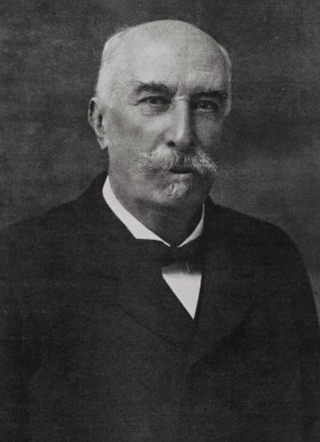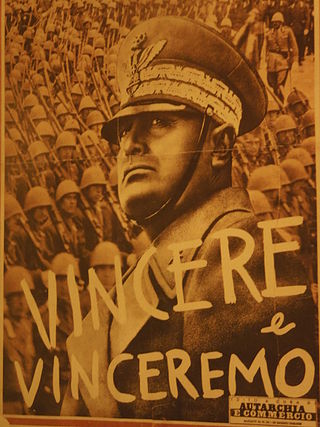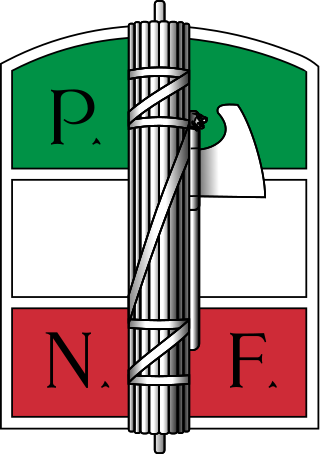
Gaetano Salvemini was an Italian socialist and anti-fascist politician, historian, and writer. Born in a family of modest means, he became an acclaimed historian both in Italy and abroad, particularly in the United States, after he was forced into exile by Benito Mussolini's Italian fascist regime.

Giovanni Giolitti was an Italian statesman. He was the prime minister of Italy five times between 1892 and 1921. He is the longest-serving democratically elected prime minister in Italian history, and the second-longest serving overall after Benito Mussolini. A prominent leader of the Historical Left and the Liberal Union, he is widely considered one of the most powerful and important politicians in Italian history; due to his dominant position in Italian politics, Giolitti was accused by critics of being an authoritarian leader and a parliamentary dictator.

The March on Rome was an organized mass demonstration and a coup d'état in October 1922 which resulted in Benito Mussolini's National Fascist Party ascending to power in the Kingdom of Italy. In late October 1922, Fascist Party leaders planned an insurrection to take place by marching on the capital. On 28 October, the fascist demonstrators and Blackshirt paramilitaries approached Rome; Prime Minister Luigi Facta wished to declare a state of siege, but this was overruled by King Victor Emmanuel III, who, fearing bloodshed, persuaded Facta to resign by threatening to abdicate. On 30 October 1922, the King appointed Mussolini as Prime Minister, thereby transferring political power to the fascists without armed conflict. On 31 October the fascist Blackshirts paraded in Rome, while Mussolini formed his coalition government.

This article covers the history of Italy as a monarchy and in the World Wars. The Kingdom of Italy was a state that existed from 17 March 1861, when Victor Emmanuel II of Sardinia was proclaimed King of Italy, until 2 June 1946, when civil discontent led to an institutional referendum to abandon the monarchy and form the modern Italian Republic. The state resulted from a decades-long process, the Risorgimento, of consolidating the different states of the Italian Peninsula into a single state. That process was influenced by the Savoy-led Kingdom of Sardinia, which can be considered Italy's legal predecessor state.

The history of fascist ideology is long and it draws on many sources. Fascists took inspiration from sources as ancient as the Spartans for their focus on racial purity and their emphasis on rule by an elite minority. Fascism has also been connected to the ideals of Plato, though there are key differences between the two. Fascism styled itself as the ideological successor to Rome, particularly the Roman Empire. From the same era, Georg Wilhelm Friedrich Hegel's view on the absolute authority of the state also strongly influenced fascist thinking. The French Revolution was a major influence insofar as the Nazis saw themselves as fighting back against many of the ideas which it brought to prominence, especially liberalism, liberal democracy and racial equality, whereas on the other hand, fascism drew heavily on the revolutionary ideal of nationalism. The prejudice of a "high and noble" Aryan culture as opposed to a "parasitic" Semitic culture was core to Nazi racial views, while other early forms of fascism concerned themselves with non-racialized conceptions of the nation.

Filippo Turati was an Italian sociologist, criminologist, poet and socialist politician.

Italian fascism, also classical fascism and Fascism, is the original fascist ideology, which Giovanni Gentile and Benito Mussolini developed in Italy. The ideology of Italian Fascism is associated with a series of political parties led by Mussolini: the National Fascist Party (PNF), which governed the Kingdom of Italy from 1922 until 1943, and the Republican Fascist Party (PFR), which governed the Italian Social Republic from 1943 to 1945. Italian fascism also is associated with the post–war Italian Social Movement (MSI) and later Italian neo-fascist political organisations.

The Fasci Italiani di Combattimento was an Italian fascist organisation created by Benito Mussolini in 1919. It was the successor of the Fasci d'Azione Rivoluzionaria, being notably further right than its predecessor. The Fasci Italiani di Combattimento was reorganised into the National Fascist Party in 1921.
General elections were held in Italy on 6 April 1924 to elect the members of the Chamber of Deputies. They were held two years after the March on Rome, in which Benito Mussolini's National Fascist Party rose to power, and under the controversial Acerbo Law, which stated that the party with the largest share of the votes would automatically receive two-thirds of the seats in Parliament as long as they received over 25% of the vote.
Il Popolo d'Italia was an Italian newspaper published from 15 November 1914 until 24 July 1943. It was founded by Benito Mussolini as a pro-war newspaper during World War I, and it later became the main newspaper of the Fascist movement in Italy after the war. It published editions every day with the exception of Mondays.
Squadrismo was the movement of squadre d'azione, the fascist militias that were organised outside the authority of the Italian state and led by local leaders called ras. The militia originally consisted of farmers and middle-class people, who created their own defence from revolutionary socialists. Squadrismo became an important asset for the rise of the National Fascist Party, led by Benito Mussolini, and systematically used violence to eliminate any political parties that were opposed to Italian Fascism.

The Kingdom of Italy was a state that existed from 17 March 1861, when Victor Emmanuel II of Sardinia was proclaimed King of Italy, until 12 June 1946, when the monarchy was abolished, following civil discontent that led to an institutional referendum on 2 June 1946, which resulted in a modern Italian Republic. The kingdom was established through the unification of several states over a decades-long process, called the Risorgimento. That process was influenced by the Savoy-led Kingdom of Sardinia, which can be considered Italy's legal predecessor state.

The National Fascist Party was a political party in Italy, created by Benito Mussolini as the political expression of Italian fascism and as a reorganisation of the previous Italian Fasces of Combat. The party ruled the Kingdom of Italy from 1922 when Fascists took power with the March on Rome until the fall of the Fascist regime in 1943, when Mussolini was deposed by the Grand Council of Fascism. It was succeeded, in the territories under the control of the Italian Social Republic, by the Republican Fascist Party, ultimately dissolved at the end of World War II.

The Italian Nationalist Association was Italy's first nationalist political movement founded in 1910, under the influence of Italian nationalists such as Enrico Corradini and Giovanni Papini. Upon its formation, the ANI supported the repatriation of Austrian held Italian-populated lands to Italy and was willing to endorse war with Austria-Hungary to do so. The party had a paramilitary wing called the Blueshirts. The authoritarian nationalist faction of the ANI would be a major influence for the National Fascist Party of Benito Mussolini formed in 1921. In 1922 the ANI participated in the March on Rome, with an important role, but it was not completely aligned with Benito Mussolini's party. Nevertheless, the ANI merged into the Fascist Party in October 1923.

Benito Amilcare Andrea Mussolini was an Italian dictator who founded and led the National Fascist Party (PNF). He was Prime Minister of Italy from the March on Rome in 1922 until his deposition in 1943, as well as Duce of Italian fascism from the establishment of the Italian Fasces of Combat in 1919 until his summary execution in 1945 by Italian partisans. As dictator of Italy and principal founder of fascism, Mussolini inspired and supported the international spread of fascist movements during the inter-war period.
Events from the year 1914 in Italy.
The Pact of Pacification or Pacification Pact was a peace agreement officially signed by Benito Mussolini, who would later become dictator of Italy, and other leaders of the Fasci with the Italian Socialist Party (PSI) and the General Confederation of Labor (CGL) in Rome on August 2 or 3, 1921. The Pact called for “immediate action to put an end to the threats, assaults, reprisals, acts of vengeance, and personal violence of any description,” by either side for the “mutual respect” of “all economic organizations.” The Italian Futurists, Syndicalists and others favored Mussolini’s peace pact as an attempt at “reconciliation with the Socialists.” Others saw it as a means to form a “grand coalition of new mass parties” to “overthrow the liberal systems,” via parliament or civil society.
Events from the year 1921 in Italy.
Fascist syndicalism was an Italian trade syndicate movement that rose out of the pre-World War II provenance of the revolutionary syndicalist movement led mostly by Edmondo Rossoni, Sergio Panunzio, Angelo Oliviero Olivetti, Michele Bianchi, Alceste De Ambris, Paolo Orano, Massimo Rocca, and Guido Pighetti, under the influence of Georges Sorel, who was considered the "'metaphysician' of syndicalism". The fascist syndicalists differed from other forms of fascism in that they generally favored class struggle, worker-controlled factories and hostility to industrialists, which lead historians to portray them as "leftist fascist idealists" who "differed radically from right fascists." Generally considered one of the more radical fascist syndicalists in Italy, Rossoni was the "leading exponent of fascist syndicalism", and sought to infuse nationalism with "class struggle".

Italy entered into the First World War in 1915 with the aim of completing national unity: for this reason, the Italian intervention in the First World War is also considered the Fourth Italian War of Independence, in a historiographical perspective that identifies in the latter the conclusion of the unification of Italy, whose military actions began during the revolutions of 1848 with the First Italian War of Independence.











